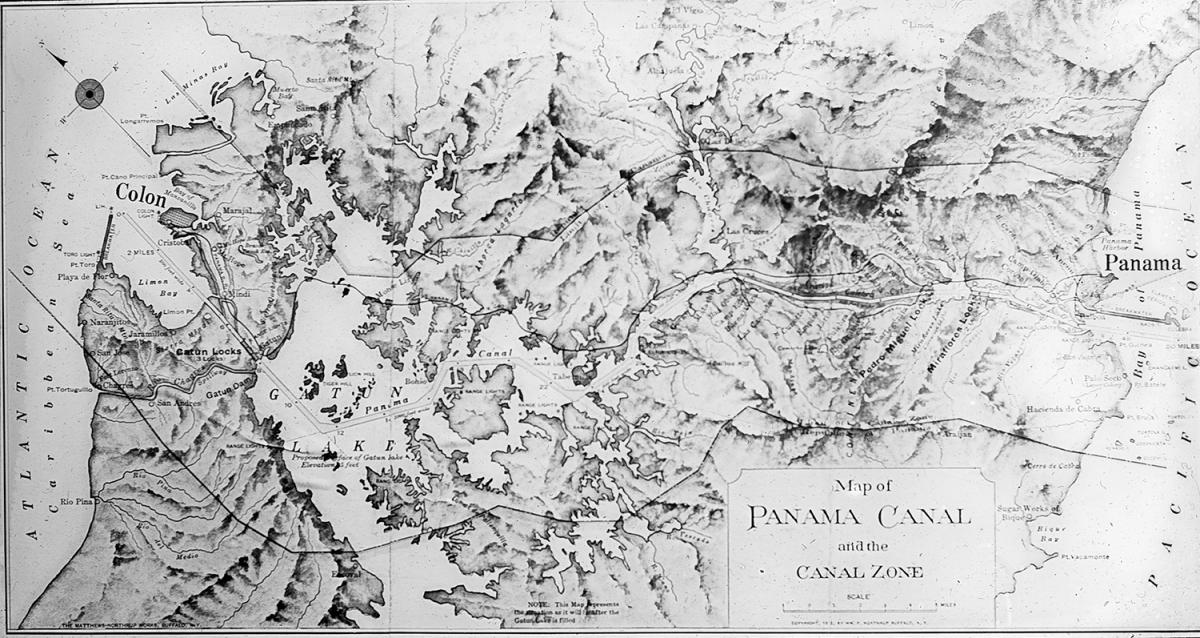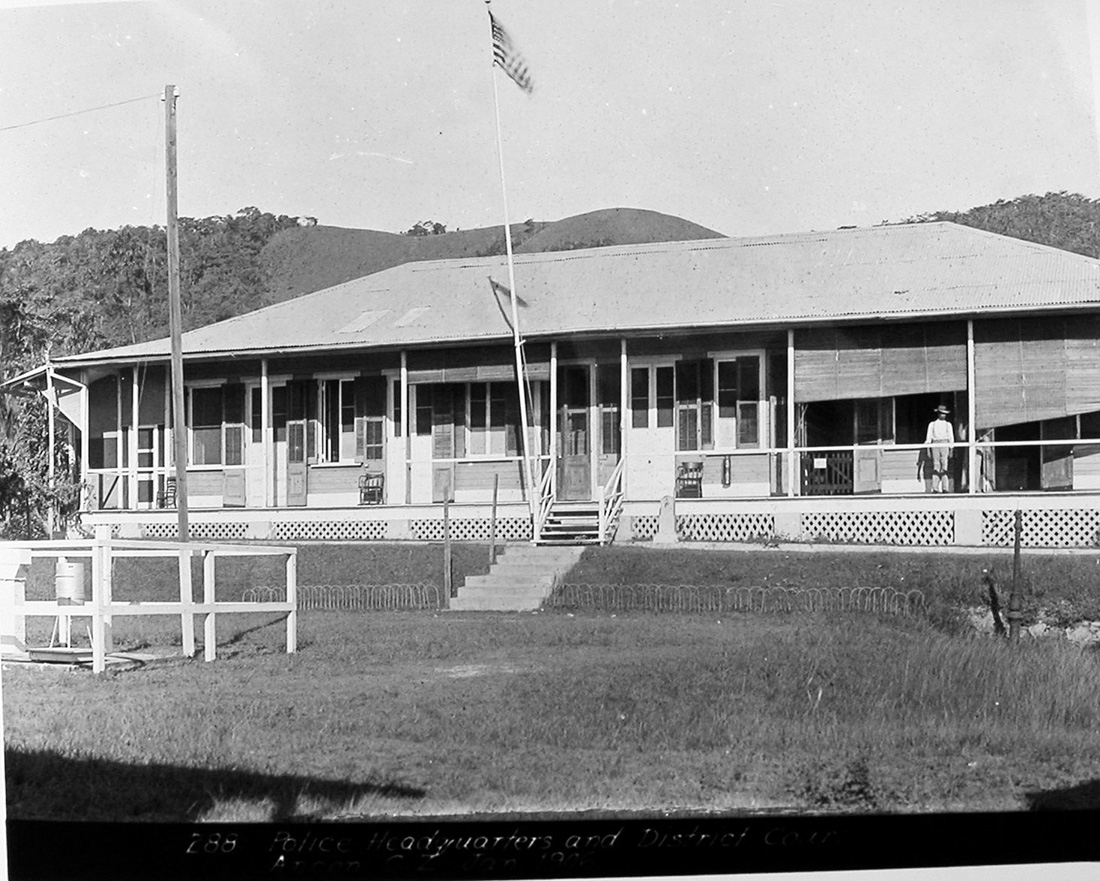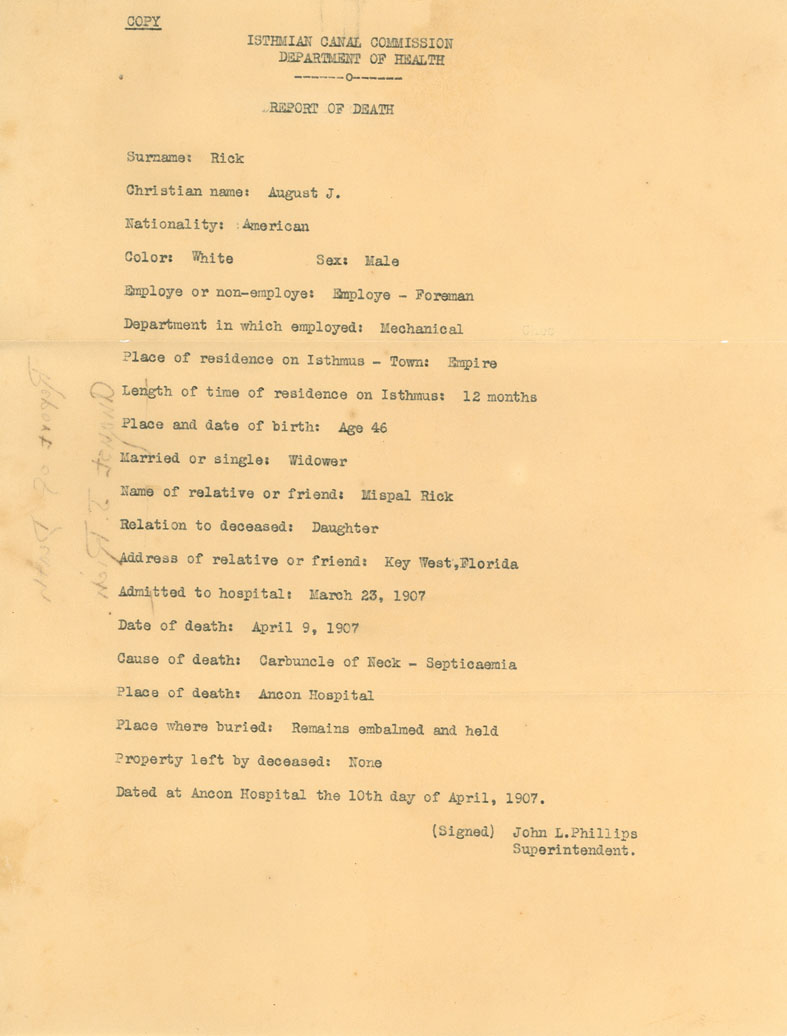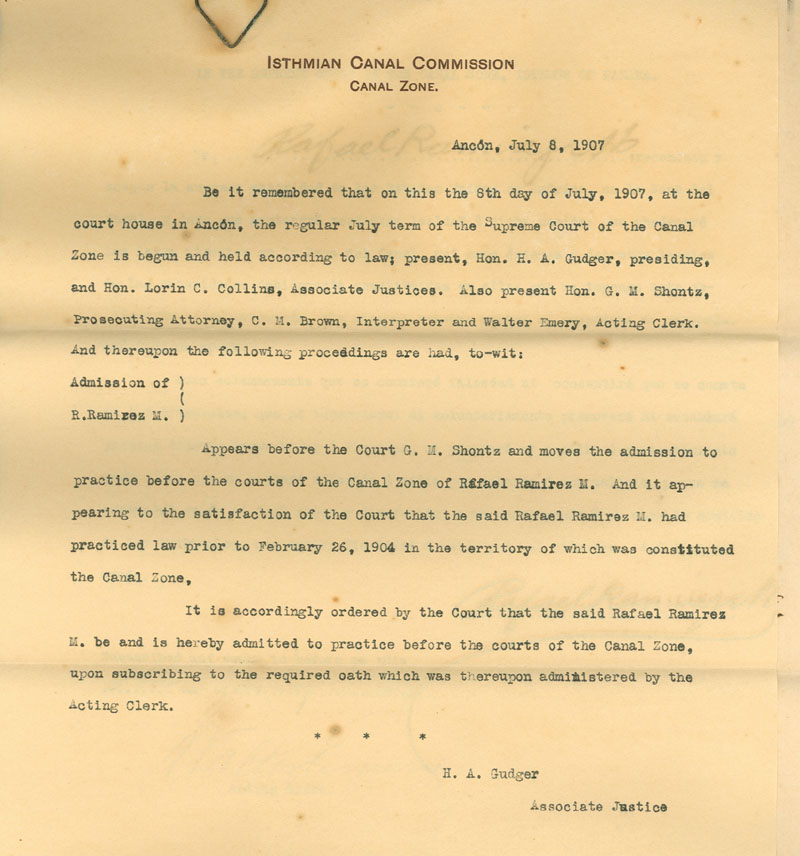
Looking for an Ancestor in the Panama Canal Zone, 1904-1914
Fall 2007, Vol. 39, No. 3 | Genealogy Notes
By Robert Ellis
In 10 years, between 1904 and 1914, the United States mounted and completed one of the most massive construction projects in history—the building of the Panama Canal. To create this ribbon of water between the Pacific and Atlantic Oceans, the Isthmus Canal Commission excavated 232 million cubic feet of soil. Manpower was the key to success. It wasn't long before the area that became known as the Panama Canal Zone—10 miles wide and about 50 miles long, and about 436 square miles—became crowded with workers. According to the 1912 census of the Panama Canal, the population of the Canal Zone, which shifted continuously with the workflow, was 62,000. More than half, approximately 36,000, were unmarried men, and 40 nationalities were listed.
Order and a legal structure in such a small, densely populated area were immediately essential. The United States gained sovereignty over the territory with the signing of the Hay–Bunau-Varilla Treaty on November 18, 1903, and quickly established a government. An executive order of May 9, 1904, authorized the Isthmian Canal Commission, with the approval of the U.S. War Department, "to make all needful rules and regulations for the government of the zone and for the correct administration of the military, civil, and judicial affairs." Laws in effect before February 26, 1904, would be enforced unless the Isthmian Canal Commission altered or annulled the law. The commission appointed a temporary judge for the Canal Zone, and original tribunals, police magistrates, and justices of the peace administered the municipal laws. On March 22, 1907, President Theodore Roosevelt issued an executive order that established a new "Code of Civil Procedure" that would be in force May 1, 1907.
In the National Archives, Records of District Courts of the United States (Record Group 21) contain the records of courts established in the Canal Zone under American jurisdiction. In the case files and in the marriage records found in Records of the Panama Canal Zone (Record Group 185), researchers may find an unexpected source of genealogical information.
The Panama Canal Act of 1912 (37 Stat. 560) established the Panama Canal Zone as a permanent organization that assumed governmental functions. This act firmly established the federal courts in the Panama Canal Zone into three circuit courts: First Judicial Circuit (Balboa); Second Judicial Circuit (Empire, Gargona, Ancon); and Third Judicial Circuit (Cristobal). The three circuit courts each had three courts: the criminal court, the civil court, and the probate court. The judges for these courts were not federal judges but were appointed and approved by the Panama Canal Commission. The dates for the series of records for the criminal, civil, and probate courts vary.
In each court, the clerk of the court kept a docket book. The docket book contained the names of the plaintiff and the defendant, the date the case was filed, a listing of all the actions pertaining to the case, and the final judgment. The names of the plaintiffs and the defendants are listed alphabetically in the front of each volume.
The Panama Canal Zone Criminal Courts
The criminal court handled cases against individuals such as assault (battery, with intent to kill), selling lottery tickets, burglary, forgery, rape, crimes against nature, white slave laws, and murder. In addition to crimes against individuals, the court tried cases involving violation of quarantine laws, violation of navigation laws, desertions from ships, and individuals returning to the Canal Zone after being deported. The court also heard criminal cases that were appealed from magistrate courts and justices of the peace.
Records for the criminal courts cover these series and dates:
- First Judicial Circuit: criminal dockets, 1904–1914, and criminal case files, 1905–1914.
- Second Judicial Circuit: criminal dockets, 1904–1914; criminal case files, 1904–1914; record of complaints and information, 1904–1907; and record of subpoenas, 1905–1913.
- Third Judicial Circuit: criminal dockets, 1904–1914, and criminal case files, 1904–1920.
A jury of three men rendered criminal judgments. In Government of the Canal Zone v. Adolphus Coulson, Second Judicial Circuit Court criminal case #239, the court convicted Coulson of murdering his wife, Marian Coulson, by arsenic poisoning. The jury consisted of H. A. Gudger, circuit judge; H. L. Ross, municipal judge of Gorgona; and R. B. Myers, municipal judge of Empire, who ordered that Coulson be hung by the neck until dead on September 13, 1907. The case was appealed to the Supreme Court of the Panama Canal Zone, and the conviction was upheld.
Coulson's attorney filed a writ of error to the U.S. Supreme Court, which dismissed the writ for want of jurisdiction. Later, the attorney filed a petition for habeas corpus to the Supreme Court, arguing that Coulson was unlawfully held in the Canal Zone by the warden of the penitentiary because the case had been heard by three judges, not a jury of 12 men. On November 9, 1908, Chief Justice Melville W. Fuller denied the petition because the U.S. Supreme Court did not have appellate jurisdiction over Canal Zone courts. Until the government of the Panama Zone was permanently established on April 1, 1914, the Supreme Court of the Canal Zone was the last court of appeal. On March 12, 1909, at 1 p.m., Coulson was executed in the penitentiary at Culebra.
Adolphus Coulson is listed in the Index to the Gorgas Hospital Mortuary Registers, 1906–1991, a database available through Access to Archival Databases (AAD) on the National Archives web site. The index contains 26,213 names of U.S. military personnel and civilian employees. The fields in the database include name, age, race, nationality, date of death, place of death, and other information. Another piece of important genealogical information is the name of the person responsible for the remains and the section and row of the place of burial.
We learn from the database that Coulson was listed as black; he was from Barbados; he died on March 12, 1909, at the penitentiary at Culebra; his mother, Margaret Miller, was responsible for his remains; and he was buried in grave number 431.
The Panama Canal Zone Civil Courts
The civil court handled cases involving personal injury, damages, lawsuits between businesses, and divorces.
Records for the civil courts cover these series and dates:
- First Judicial Circuit: civil dockets, December 1904–April 19, 1914, and civil case files, 1905–1914.
- Second Judicial Circuit: civil case files, 1904–1914.
- Third Judicial Circuit: civil dockets, 1904–1914, and civil case files, 1904–1913.
In civil case #150, Blanca Zander White v. Alfred White, from the First Judicial Circuit, Blanca filed for divorce in the April term of 1913. According to her petition, they were married in the town of Ancon on February 15, 1912, and Alfred deserted her in June or July of 1912. Blanca gave birth to a child on or about November 5, 1912. She also declared that Alfred earned $200.00 gold a month working for the Isthmian Canal Commission. In Alfred's answer to the petition, he stated that his wife had carried on an open liaison with Manuel Castillo, and the child was really Castillo's. On May 13, 1913, Judge Gudger ordered that the marriage be dissolved, and Blanca received $50.00 a month as alimony. Neither party, however, was allowed to contract another marriage.
The Panama Canal Zone Probate Courts
The probate court handled cases involving adoptions, insanity, and estates. The majority of probate cases for 1904 to 1914 concerned insanity and estates, which are potentially good sources for genealogical information.
Records for the probate courts cover these series and dates:
- First Judicial Circuit: probate dockets, 1907–1914, and probate case files, 1907–1914.
- Third Judicial Circuit: probate case files, 1912–1972.
One insanity case from 1911, Balboa probate case file #60, concerned an Isaiah Mendez, age about 24 years old. Mendez, a West Indian, was found wandering, and an order of commitment to the asylum was issued on December 30, 1911. The probate case files have documents concerning observation and commitment but do not contain the hospital patient's medical records.
Deaths were common in the Panama Canal Zone due to work-related injuries and diseases. According to the probate case file, In the Matter of the Estate of August J. Rick, from the First Judicial Circuit, Rick died on April 10, 1907, in the Ancon Hospital. Although his entire possessions fit into one steamer trunk, the file is fairly extensive. The full inventory of goods and chattels lists 1 razor; 4 pearl buttons; one slipper, straw; 11 shirts, 2 undershirts; 2 pairs of drawers; and other items. The file also contains an Isthmian Canal Commission Department of Health's Report of Death that lists the following facts about Rick: American; foreman in Mechanical Department; lived in the Panama Canal Zone for 12 months; 46 years old; a widower; and had a daughter named Mispal Rick who lived in Key West, Florida.
Attorney Admission Case Files, 1904–1939
This series of records consists of the files of attorneys who were admitted to the bar of the courts of the Panama Canal Zone, including Panama Canal Zone justices. The records are arranged alphabetically by the surname of the attorney and justice.
Rafael Ramirez M. practiced law in the territory before it became the Canal Zone. Therefore, when he applied to the bar on July 8, 1907, and proved that he practiced prior to creation of the Panama Canal Zone, the court automatically admitted Ramirez to the bar. He signed an oath written in Spanish.
The file for Felix E. Porter contains genealogical information. Porter was admitted to the bar on July 29, 1910. According to a newspaper clipping in the file, Porter was born on a farm in Kemper, Mississippi; educated at a grammar school in Gainesville, Alabama, and a high school in Binghamton, New York; and graduated from the Southern University of Greensboro in Alabama. He taught school at Scooba and Shuqualak, Mississippi, and Pratt Mines, Alabama, before he passed the civil service examination in October 1890. Porter moved to Washington, DC, to work in the War Department and graduated from the National University Law School (now Georgetown Law School) in 1894.
In March 1906, Porter was transferred to the disbursing office of the Isthmian Canal Commission in the Panama Canal Zone. Later, in August 1910, he was appointed the assistant prosecuting attorney for the Canal Zone, but he resigned in 1911 to go into private practice. In 1927 Porter faced disbarment hearings for making false and defamatory statements about the Balboa civil court and Judge Guy H. Martin. The proceedings are found in case file #855, In the Matter of the Suspension or Disbarment of Felix E. Porter. On January 11, 1928, Porter was prohibited "from practicing as attorney at law in all the courts of the Canal Zone for a period of four years, and thereafter until the further order of this court removing such suspend." After Porter was disbarred, he continued to appeal the decision in the court. The final motion in the case was filed by his attorney, John O. Collins, on March 1, 1929. Collins's motion stated that "Mr. Porter died at Gorgas Hospital at Ancon in the Canal Zone, on January 19, 1929. . . . It is now moved that an order be entered discontinuing this action."
Marriage Records
In Record Group 185, Records of the Panama Canal Zone, the National Archives has only Panama Canal Zone marriage certificates through 1979. For a copy of a pre-1979 marriage license, write to Civilian Records, National Archives and Records Administration, 8601 Adelphi Road, College Park, MD 20740-6001. For Panama Canal Zone marriages issued after 1979, write to the Republic of Panama.
Grace Collins, daughter of Associate Justice Lorin C. Collins of the Supreme Court of the Canal Zone, was married in May 1907 in the Panama Canal Zone; however, she was not sure that she was legally married. The law of Panama authorized only priests of the Catholic Church to perform legal marriages, and Grace and Marine Capt. John F. McGill had been married by an Episcopal archdeacon. To allow ministers of other denominations to perform marriages, President Roosevelt had issued an executive order on March 13, 1907, authorizing "that marriages in the Canal Zone may be celebrated by any minister of the Gospel in regular standing in the church or society to which he belongs."
But Panama recognized only the Catholic religion. A question of law concerning the word "recognized any minister of the Gospel in regular standing in the church" propelled President Roosevelt to issue an additional executive order on May 31, 1907, authorizing any judicial officer of the Canal Zone or any minister of any religious society or denomination to celebrate marriages within the Canal Zone. First, the parties must procure a marriage license of the clerk of the circuit in which the marriage was to be performed. The man must be 17 years old, and the woman must be 14 years old. The person performing the marriage ceremony must certify and return the marriage license to the circuit court. The clerk collected two dollars gold for issuing and recording each marriage license.
Naturalization Records
Panama Canal Zone courts did not have the authority to receive petitions for naturalization. Individuals living in the Canal Zone did not meet the requirement of living continuously for five years in the United States for naturalization, even if they had filed their first papers in the United States, then moved to the Panama Canal before receiving their second papers. American citizenship was important because American canal employees were granted vacations, and after working for two years they received the Canal Zone medal.
After the act of 1914, the courts continued administering justice until 1979. The records help tell the stories of the thousands of people who lived and worked in the Panama Canal Zone, the decisions they made, the actions they took, and the details of the lives they led in a special place where a passageway from the Atlantic to the Pacific Ocean was created.
Robert Ellis is an archivist in the Old Military and Civil Branch at the National Archives in Washington, DC. He is responsible for the records of the United States Supreme Court, the U.S. Court of Claims, the District Court for the District of Columbia, and other federal court records housed there. His previous article for Prologue described how posters were distributed by the Boy Scouts during World War II.
Note on Sources
The author is very grateful to the people who gave their time and talent to help with the research on this article. Thanks to Rebecca Sharp for doing the research to locate the photographs. Tim Syzek and Torin Pollock, NARA Library staff, assisted me in locating publications. Patrice Brown and David Pfeiffer searched the Panama Canal Zone marriage records for particular individuals who were married between 1904 and 1914. Constance Potter suggested the topic and provided valuable feedback.
The information for this article was taken primarily from Record Group 21, Records of the District Courts of the United States, Panama Canal Zone, at the National Archives Building in Washington, DC. Reference has also been made to Willis J. Abbot, Panama and the Canal: In Picture and Prose (London: Syndicate Publishing Company, 1913); Michael L. Conniff, Black Labor on a White Canal: Panama 1904–1981 (Pittsburgh, PA: University of Pittsburgh Press, 1985); Canal Record, volumes 1–3 (Mount Hope, Canal Zone: Isthmian Canal Commission Printing Office, 1910); The Code of Civil Procedure of the Canal Zone (Washington, DC: Government Printing Office, 1907); Lt. Col. George W. Goethals, U.S.A, The Isthmian Canal (Washington, DC: Government Printing Office, 1909); and Executive Orders Relating to Isthmian Canal Commission (Washington, DC: Government Printing Office, 1911).





